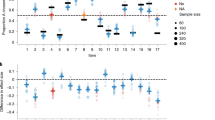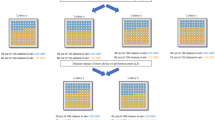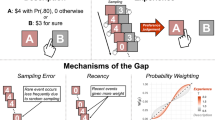Abstract
The growing literature on how people learn to make decisions based on experience focuses on two types of paradigms. In one paradigm, people are faced with a choice, and must retrospectively consult past experience of similar choices to decide what to do. In the other paradigm, people are faced with a choice, and then have the opportunity prospectively to gather new experiences that might help them make that choice. The current paper examines the joint impact of both retrospective and prospective experiences. Two experiments reveal strong interactions. In Study 1, repeated experience with new samples appears to reduce sensitivity to the average outcome in the samples and enhances underweighting of rare events. Study 2 shows that repeated experience with pre-choice samples can reverse the impact of the new information (and decrease the tendency to select the alternative that provides the best outcome in the new sample). The results suggest that prospectively gathering new samples can have two, potentially contrasting, influences on choice: the first focuses on the sample’s face value and selects the option with the higher value in the new sample; by contrast, the second treats the new sample as a cue to recall similar prior experiences, which in turn drive choice. The paper concludes with a discussion of the possibility that part of the descriptive value of prospect theory reflects the fact that it summarizes the joint impact of similar “face-or-cue” processes.





Similar content being viewed by others
Notes
These definitions imply that the existence of the gap does not imply underweighting of rare events in decisions from experience. For example, consider an experiment that studies decisions between R “10 with probability 0.9, 0 otherwise” and S “9 for sure” using the sampling and the description paradigms. Assume that the R-rate (the choice rate of the option that pays more with higher probability) is 40% in the sampling paradigm, and 10% in the description paradigm. The gap in this example is large (40% − 10% = 30%), but the results do not exhibit underweighting of rare events in the sampling paradigm (as the choice rate of the option that pays more with higher probability is lower than 50%).
When the feedback is limited to the obtained payoff, the tendency to underweight negative rare outcomes can be masked by the hot stove effect (Denrell & March, 2001).
While Wulff et al. (2018), did not find underweighting of rare events when the proportion of the rare outcome in the samples equaled its probability, they did find a weak description-experience gap even in this case. That is, the implied weighting of the rare outcomes was lower in decision from experience than in decisions for description.
This analysis was not planned in advanced, it was conducted in response to a reviewer’s request. The degree of freedom reflects the fact that only 41 participants experienced and responded in time to a sample with two rare events in the first block, and our analysis used a within person test. Additional analyses lead to similar conclusions. For example, the R-rate in the very first trial with a sample containing two rare events (62.5%) is significantly higher than the rate in all other trials with two rare events (37%), t(39) = 3.86, p = 0.0004. Similarly, the R-rate in the very first trial with a sample with two or more rare events (55%) is significantly higher than the rate in all other trials with two or more rare events (40%), t(37) = 2.10, p = 0.043.
The decrease in the risk rate given a sample with two rare outcomes could also be explained by assuming an increase in risk aversion with experience. However, this assertion cannot capture the flat learning curves observed when the sample included zero, one, or more than two rare outcomes.
Notice that Condition EV simulates natural situations, like the sneakers example, in which the sampling (e.g., trying the sneakers in the store) provide less information than the feedback for the actual decision (e.g., buying and wearing the sneakers).
The wise idea of presenting each problem twice was introduced by Wakker. However, his initial reaction to the results was not positive. He said (smiling, more or less) “these subjects are not very smart, not sure that I want to run more experiments.” The clarification of the magnitude of within-person choice variability has contributed to Erev’s interest in the implications of noise (e.g., Erev et al., 1994), and the impact of experience (e.g., Barron & Erev, 2003).
References
Abdellaoui, M., L’Haridon, O., & Paraschiv, C. (2011). Experienced vs. described uncertainty: Do we need two prospect theory specifications? Management Science, 57(10), 1879–1895.
Achtziger, A., & Alós-Ferrer, C. (2014). Fast or rational? A response-times study of Bayesian updating. Management Science, 60(4), 923–938.
Barron, G., & Erev, I. (2003). Small feedback-based decisions and their limited correspondence to description-based decisions. Journal of Behavioral Decision Making, 16(3), 215–233.
Chater, N., Zhu, J. Q., Spicer, J., Sundh, J., León-Villagrá, P., & Sanborn, A. (2020). Probabilistic biases meet the Bayesian brain. Current Directions in Psychological Science, 29(5), 506–512.
Chen, D. L., Schonger, M., & Wickens, C. (2016). oTree—an open-source platform for laboratory, online, and field experiments. Journal of Behavioral and Experimental Finance, 9, 88–97.
Cohen, D., Plonsky, O., & Erev, I. (2020). On the impact of experience on probability weighting in decisions under risk. Decision, 7(2), 153.
de Palma, A., Abdellaoui, M., Attanasi, G., Ben-Akiva, M., Erev, I., Fehr-Duda, H., Fok, D., Fox, C. R., Hertwig, R., Picard, N., & Wakker, P. P. (2014). Beware of black swans: taking stock of the description–experience gap in decision under uncertainty. Marketing Letters, 25(3), 269–280.
Denrell, J., & March, J. G. (2001). Adaptation as information restriction: the hot stove effect. Organization Science, 12(5), 523–538.
Erev, I., Ert, E., Plonsky, O., Cohen, D., & Cohen, O. (2017). From anomalies to forecasts: toward a descriptive model of decisions under risk, under ambiguity, and from experience. Psychological Review, 124(4), 369.
Erev, I., Glozman, I., & Hertwig, R. (2008). What impacts the impact of rare events. Journal of Risk and Uncertainty, 36(2), 153–177.
Erev, I., & Haruvy, E. (2016). Learning and the economics of small decisions. In J. H. Kagel & A. E. Roth (Eds.), The handbook of experimental economics (Vol. 2, pp. 638–716). Princeton University Press.
Erev, I., Wallsten, T. S., & Budescu, D. V. (1994). Simultaneous over-and underconfidence: the role of error in judgment processes. Psychological Review, 101(3), 519.
Glöckner, A., Hilbig, B. E., Henninger, F., & Fiedler, S. (2016). The reversed description-experience gap: disentangling sources of presentation format effects in risky choice. Journal of Experimental Psychology: General, 145(4), 486.
Hertwig, R., Barron, G., Weber, E. U., & Erev, I. (2004). Decisions from experience and the effect of rare events in risky choice. Psychological Science, 15(8), 534–539.
Hertwig, R., & Erev, I. (2009). The description–experience gap in risky choice. Trends in Cognitive Sciences, 13(12), 517–523.
Hertwig, R., & Pleskac, T. J. (2008). The game of life: how small samples render choice simpler. In N. Chater & M. Oaksford (Eds.), The probabilistic mind: Prospects for Bayesian cognitive science (pp. 209–235). Oxford, England: Oxford University Press.
Jessup, R. K., Bishara, A. J., & Busemeyer, J. R. (2008). Feedback produces divergence from prospect theory in descriptive choice. Psychological Science, 19(10), 1015–1022.
Kahneman, D., & Tversky, A. (1979). Prospect theory: an analysis of decision under risk. Econometrica, 47(2), 263–292.
Kőszegi, B., & Rabin, M. (2006). A model of reference-dependent preferences. The Quarterly Journal of Economics, 121(4), 1133–1165.
Lejarraga, T., & Gonzalez, C. (2011). Effects of feedback and complexity on repeated decisions from description. Organizational Behavior and Human Decision Processes, 116(2), 286–295. https://doi.org/10.1016/j.obhdp.2011.05.001.
Marchiori, D., Di Guida, S., & Erev, I. (2015). Noisy retrieval models of over-and undersensitivity to rare events. Decision, 2(2), 82.
Plonsky, O., & Erev, I. (2017). Learning in settings with partial feedback and the wavy recency effect of rare events. Cognitive Psychology, 93, 18–43.
Plonsky, O., & Teodorescu, K. (2020). Perceived patterns in decisions from experience and their influence on choice variability and policy diversification: a response to Ashby, Konstantinidis, & Yechiam, 2017. Acta Psychologica, 202, 102953.
Plonsky, O., Teodorescu, K., & Erev, I. (2015). Reliance on small samples, the wavy recency effect, and similarity-based learning. Psychological Review, 122(4), 621–647.
Skinner, B. (1953). Science and human behavior. Free Press.
Tsetsos, K., Chater, N., & Usher, M. (2012). Salience driven value integration explains decision biases and preference reversal. Proceedings of the National Academy of Sciences, 109(24), 96599664.
Wakker, P. P. (1990). Characterizing optimism and pessimism directly through comonotonicity. Journal of Economic Theory, 52(2), 453–463.
Wakker, P. P. (2010). Prospect theory: for risk and ambiguity. Cambridge University Press. https://doi.org/10.1017/CBO9780511779329
Wakker, P. P., Erev, I., & Weber, E. U. (1994). Comonotonic independence: the critical test between classical and rank-dependent utility theories. Journal of Risk and Uncertainty, 9(3), 195–230.
Wulff, D. U., Mergenthaler Canseco, M., & Hertwig, R. (2018). A meta-analytic review of two modes of learning and the description-experience gap. Psychological Bulletin, 144(2), 140–176.
Yechiam, E., Barron, G., & Erev, I. (2005). The role of personal experience in contributing to different patterns of response to rare terrorist attacks. Journal of Conflict Resolution, 49(3), 430–439.
Acknowledgements
Ido Erev was supported by the Israel Science Foundation (grant no. 535/17). Nathaniel J. S. Ashby was partially supported by a Technion fellowship. Nick Chater was supported by ERC grant 295917-RATIONALITY, the ESRC Network for Integrated Behavioural Science [grant number ES/K002201/1], the Leverhulme Trust [grant number RP2012-V-022], and RCUK Grant EP/K039830/1.
Author information
Authors and Affiliations
Corresponding author
Additional information
Publisher's Note
Springer Nature remains neutral with regard to jurisdictional claims in published maps and institutional affiliations.
Rights and permissions
About this article
Cite this article
Erev, I., Yakobi, O., Ashby, N.J.S. et al. The impact of experience on decisions based on pre-choice samples and the face-or-cue hypothesis. Theory Decis 92, 583–598 (2022). https://doi.org/10.1007/s11238-021-09856-7
Accepted:
Published:
Issue Date:
DOI: https://doi.org/10.1007/s11238-021-09856-7




